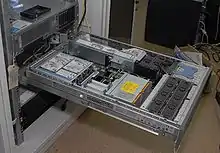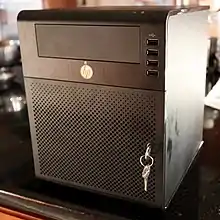ProLiant
ProLiant is a brand of server computers that was originally developed and marketed by Compaq and currently marketed by Hewlett Packard Enterprise. After Compaq merged with Hewlett-Packard (HP), HP retired its NetServer brand in favor of the ProLiant brand.[1] HP ProLiant systems led the x86 server market in terms of units and revenue during first quarter of 2010.[2] The HP ProLiant servers offer many advanced server features such as redundant power supplies, Out-of-band management with iLO or Lights-out 100, Hot-swap components and up to 8-Socket systems.[3]
.jpeg.webp) HP ProLiant DL380 G6 | |
| Developer | Hewlett Packard Enterprise |
|---|---|
| Type | Desktop or Rack-mounted server |
| Release date | 1993 (Compaq ProLiant); 2003 (HP ProLiant) |
| Predecessor | Compaq SystemPro XL |
Product lines

Modular Line (ML)
ML server models are tower-based. They aim towards maximum expandability.
Density Line (DL) and RISC Line (RL)
DL server models are rack-based. They aim towards a balance between density and computing power.
Available models through product generations
| Model | Product generation | ||||||||||
|---|---|---|---|---|---|---|---|---|---|---|---|
| 1 | 2 | 3 | 4 | 5 | 6 | 7 | 8 | 9 | 10 | 11 | |
| DL20 | |||||||||||
| DL60 | |||||||||||
| DL80 | |||||||||||
| DL100 | |||||||||||
| DL120 | |||||||||||
| DL140 | |||||||||||
| DL145 | |||||||||||
| DL160 | |||||||||||
| DL165 | |||||||||||
| DL180 | |||||||||||
| DL185 | |||||||||||
| DL320 | |||||||||||
| DL325 | |||||||||||
| DL345 | |||||||||||
| DL360 | |||||||||||
| DL365 | |||||||||||
| DL370 | |||||||||||
| DL380 | |||||||||||
| DL385 | |||||||||||
| DL560 | |||||||||||
| DL580 | |||||||||||
| DL585 | |||||||||||
| DL740 | |||||||||||
| DL760 | |||||||||||
| DL785 | |||||||||||
| DL980 | |||||||||||
| DL1000 | |||||||||||
| DL2000 | |||||||||||
| RL300 | |||||||||||
Scalable Line (SL)
SL server models are rack-based. These models are mostly used in data centers and environments where a maximum of computing power is desired.
Blade Line (BL)
BL server models are enclosure-based. They are made specially for use in a blade enclosure and cannot be used without such. Blade systems aim towards maximum density and manageability at limited rack space.
There are two models of blade enclosures: HPE BladeSystem c3000 Enclosure (8 Bays for Blades), and HPE BladeSystem c7000 Enclosures (16 Bays for Blades).
One advantage of HP/HPE Blade Enclosures compared to competitors (such as IBM Blade Systems) has been that the older generation enclosures have been able to accommodate new generation BL servers just by upgrading the firmware for OA in the enclosure (Onboard Administrator). However improvements to back-plane of the enclosure in the new generation enclosures have enabled faster I/O capabilities (such as 10Gbit/s Ethernet adapters and switches, and Infiniband). The physical design of the enclosures has not changed since the first versions (other than the larger LCD screen at the front compared to the first generation enclosures, and new plastic covers and HPE branding on the 3rd generation enclosures).
ProLiant MicroServer

The HPE ProLiant MicroServer line of products are entry-level, low power, compact, and affordable servers meant for small business, home office, or edge computing. They offer user upgradable components and easy access to hard drives. There is the option to purchase the server with ClearOS installed in order for users to be able to enable applications via an easy-to-use web-GUI with minimal effort.
Details
ProLiant servers are separated into four main product lines - ML, DL, BL, SY, and XL (Apollo) - which generally denote form factor. The ProLiant ML line comprises tower-based servers (convertible to rack mount) with capacity for internal expansion of disks and interconnects, while the DL line comprises general purpose rack mount servers. The BL line comprises blade servers which fit within the HP BladeSystem, the SY comprises the Synergy Blades, and the XL (also known as Apollo) line comprises servers for scale out and High Performance Computing environments. The MicroServer product line addresses small and home businesses.
ProLiant servers are also split into several series which denote processor configuration. The 100, 200, 300 and 400 series comprise single and dual socket capable systems, the 500 and 600 series comprise quad socket capable systems, and the 700 and 900 series comprise eight socket capable systems. The 900 series supports up to 80 CPU cores and up to 4 TB of RAM.
Models with a '0' in the last digit use Intel processors while models with a '5' in the last digit use AMD processors.[8]
The ProLiant forms part of the HP Converged Systems, which use a common Converged Infrastructure architecture for server, storage, and networking products.[9] Designed to support 50 to 300 virtual machines, the HP ConvergedSystem 300 is configured with ProLiant servers.[10] A system administrator can manage ProLiant servers using HP OneView for converged infrastructure management.[11] HP also provide drivers a software for managing servers such as Management Component Pack which includes hp online configuration utility (hponcfg), Agentless Management Service amsd, Smart Storage Administrator (SSA) ssa, Smart Storage Administrator (SSA) CLI ssacli and Smart Storage Administrator Diagnostic Utility (SSADU) CLI ssaducli.[12]
Timeline

In February 2012, HP announced the ProLiant generation 8.[13] In July 2013, HP announced a new blade server-based ProLiant, the HP Moonshot Server.
DL580 Gen8 is a "middle generation" between Gen8 and Gen9. This server has some of new features introduced in Gen9, primary there is available UEFI boot option.
Starting August 28, 2014, HP Proliant Gen9 series were available based on Intel Haswell chipset and DDR4 memory.[14] First were the HP ProLiant ML350 Gen9 Server and HP ProLiant BL460c Gen9 Blade. Servers in this generation support both BIOS and UEFI.
Starting Q4 2017, HP Proliant Gen10 servers[15][16] were available. Also in November 2017, HPE extended their Gen10 range to include AMD EPYC processors using EPYC's price v cores architectures claiming to lower cost per virtual machine (VM) by 50%.[17]
In April 2021, HPE introduced the Gen 10 Plus line of servers, which are built on third-generation Intel Xeon scalable processors. Equipped with PCIe Gen4 capabilities, the HPE ProLiant DGen10 Plus servers offer improved data transfer rates and higher networking speeds.
In November 2022, HPE introduced the ProLiant Gen 11 server line up providing support for several architectures including fourth-generation AMD EPYC processors and fourth-generation Intel Xeon scalable processors.
See also
References
- "new hp industry standard server family". FAQ. HP. Archived from the original on October 16, 2013.
- Vassou, Andrea. "IDC Report Finds Worldwide Server Market Revenues Increase" Archived July 19, 2011, at the Wayback Machine "Tech Eye" May 27, 2010, retrieved May 27, 2010
- "ProLiant DL980 G7 Server - Overview". support.hpe.com. Retrieved August 12, 2020.
- "Servers - HPE Store US". buy.hpe.com. Retrieved September 16, 2020.
- https://www.hpe.com/us/en/product-catalog/servers/proliant-servers.filters-facet_subbrand_url:proliant-dl-rack%7Cfacet_seriesname_url:gen10.hits-48.html
- https://www.hpe.com/us/en/product-catalog/servers/proliant-servers.filters-facet_subbrand_url:proliant-dl-rack%7Cfacet_seriesname_url:gen10.hits-48.html
- https://www.hpe.com/us/en/pdfViewer.html?resource=/content/hpe/country/us/en/resources/servers/family-guide/proliant-rack-tower-servers
- "Servers". hp.com.
- Rouse, Margaret. (2013-12). “Definition: Converged Infrastructure,” TechTarget.com.
- Morgan, Timothy Prickett. (April 29, 2013). “HP mashes up ProLiant, Integrity, BladeSystem, and Moonshot server business,” The Register.com.
- Tiano, Luigi. (September 28, 2013). “HP OneView Managing the Converged Infrastructure Data Center,” 1CloudRoad. Archived April 15, 2014, at the Wayback Machine
- "Drivers & Software - HPE Support Center". support.hpe.com. Retrieved September 16, 2020.
- "HP Accelerates Server Market Transformation with Self-sufficient HP ProLiant Gen8 Servers". Hewlett-Packard. February 13, 2012.
- "HP News: HP Unveils New ProLiant Gen9 Servers to Help Customers Address Evolving Data Center Demands". www8.hp.com. Retrieved September 16, 2020.
- "HPPSocialUserSignonPage - Hewlett Packard Enterprise Community". community.hpe.com. Retrieved September 16, 2020.
- Moorhead, Patrick. "HPE Goes Big With New Gen10 Servers". Forbes. Retrieved September 16, 2020.
- "HP ProLiant Server Models | Bargain Hardware".
External links
- Official website
- HPE QuickSpecs, a database of HPE product information provided by HPE
